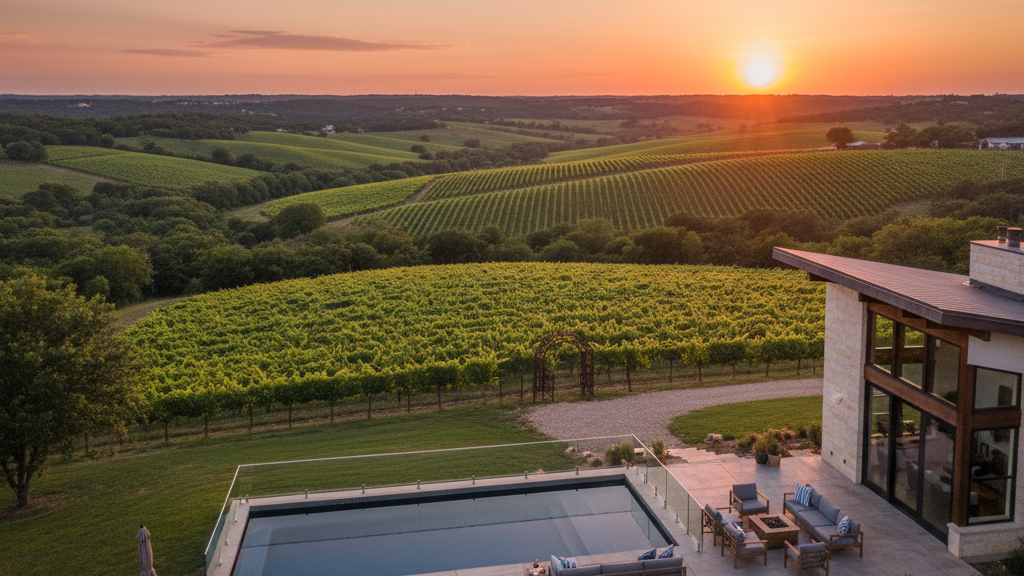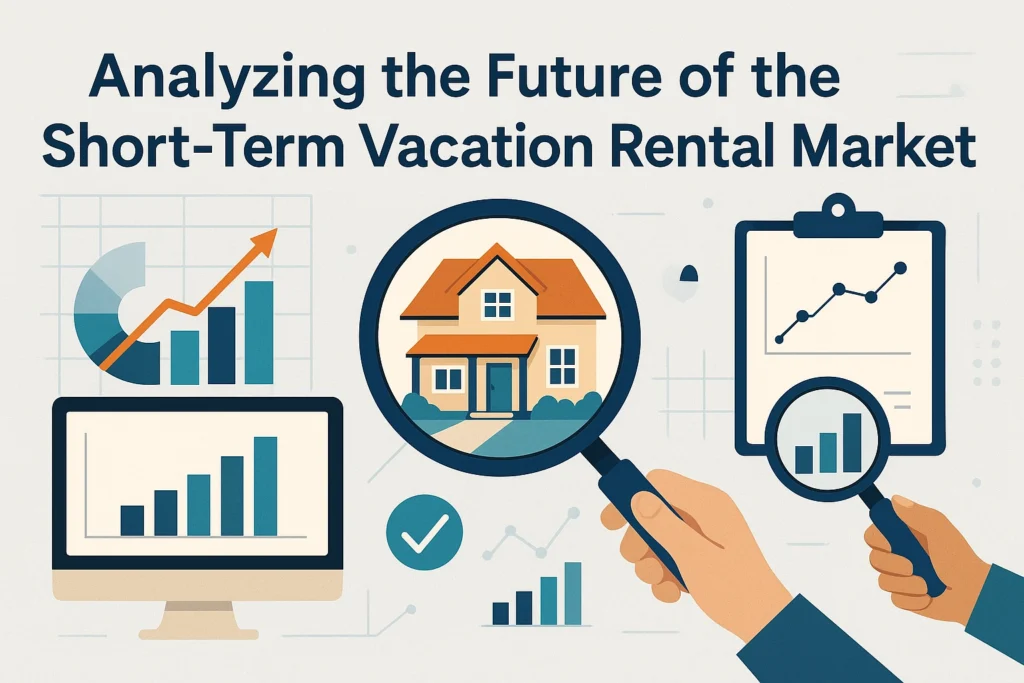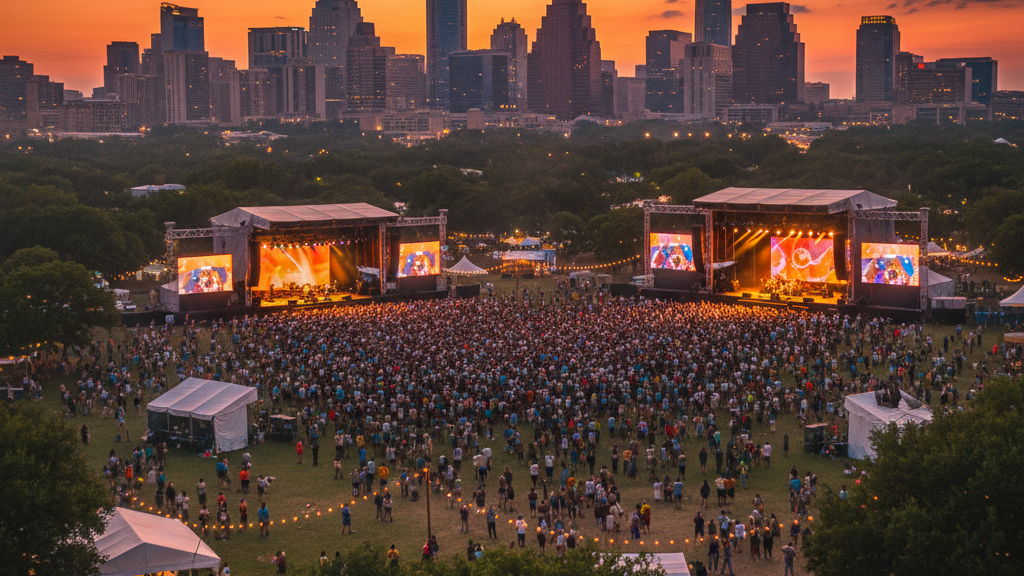On a Saturday morning in early fall, the roads leading into Dripping Springs carry a familiar rhythm—cars streaming west from Austin, following FM 290 as it winds through the Hill Country. Some are headed to the wineries that dot the landscape like jewels on a necklace. Others are checking into vacation rentals tucked between live oaks and limestone hills, trading the bustle of the city for a weekend where the loudest sound might be the cicadas at dusk.
This is Dripping Springs, Texas—a town of fewer than 5,000 residents that welcomes more than 300,000 visitors each year. It’s a place where the wine flows freely, where Hamilton Pool’s turquoise waters draw Instagram pilgrims, and where a new generation of vacation rental hosts has discovered something remarkable: you can build a meaningful income stream while offering travelers a front-row seat to one of America’s most beloved wine regions.
If you’ve ever wondered what it takes to succeed in the short-term rental business, or why so many investors are quietly buying up properties in this corner of the Texas Hill Country, pull up a chair. Let me tell you what I’ve learned about this market—este mercado especial—and why it might be one of the most compelling STR opportunities in Texas right now.
The Landscape: A Market Built on Good Foundations
The numbers tell part of the story. According to StaySTRA’s market data, Dripping Springs currently hosts 616 active short-term rentals. These properties command an average daily rate of $261 and maintain a respectable 38.7% occupancy rate, generating an average of $2,432 in revenue per listing.
But statistics alone don’t capture what makes this market hum. The real story lives in the details: the 4.84 out of 5 guest rating that speaks to a community of hosts who genuinely care about hospitality. The 4.96 location rating that reflects Dripping Springs’ position at the heart of Texas wine country. The fact that 60% of visitors come from within Texas, creating a reliable base of weekend warriors who return season after season.
The property mix is diverse—from cozy studios (42 properties) perfect for couples on a wine-tasting weekend, to sprawling 5+ bedroom estates (82 properties) that host family reunions and milestone celebrations. The sweet spot? One-bedroom properties dominate with 212 listings, followed by a healthy distribution across 2, 3, and 4-bedroom configurations. This variety means there’s room for different investment strategies and budgets.
What strikes me most, though, is the booking pattern. Nearly 77% of properties are booked 1-3 months out, and 68% maintain bookings 4-6 months in advance. That’s the sign of a stable market with consistent demand—not a flash-in-the-pan trend.
Why Dripping Springs? The Wine Country Effect
Here’s something that might surprise you: the Texas Hill Country has become the second-largest wine tourism destination in the United States, trailing only Napa Valley. Let that sink in for a moment. The region attracts more than 3 million visitors annually, and the wine industry generates a staggering $20.35 billion in economic impact across Texas.
Dripping Springs sits at a sweet spot in this wine country boom. It’s close enough to Austin (about 25 miles west) to pull weekend travelers, yet far enough to feel like an authentic escape. The Dripping Wine Trail connects notable wineries like Hawk’s Shadow, Bell Springs, and Parmeson Wines—all within minutes of each other, creating an easy loop for visitors who want to sample the region’s terroir without the sterile, corporate feel of some wine regions.
I spoke with tourism experts who emphasized that wine tourism isn’t just about the wine. It’s about the experience—the limestone hills bathed in golden afternoon light, the Hill Country cuisine, the live music venues that give this region its soul. According to recent reports, the number of active winery permits across Texas grew by 186% from 2013 to 2023. This isn’t a mature market winding down—it’s still in expansion mode.
For STR hosts, this wine tourism infrastructure is gold. Your guests aren’t just people looking for a cheap place to crash. They’re experience-seekers with disposable income, celebrating anniversaries, birthdays, and life milestones. They book wine tours, dine at local restaurants, and they’re willing to pay for quality accommodations that enhance their Hill Country experience.
What Makes Investment Here Compelling
If you’re considering entering the short-term rental market—or expanding your existing portfolio—Dripping Springs presents a compelling case. Let me break down why investors are paying attention.
First, the real estate fundamentals are stabilizing. After the pandemic-era price surge that affected markets nationwide, Dripping Springs has seen a correction. Recent data shows the median home price around $672,500 to $750,000 (depending on the source and timing), with prices down roughly 10-30% from their peak. For investors, this creates an entry point that wasn’t available 18-24 months ago. As we discussed in our recent analysis of the perfect storm for rental investors in fall 2025, market corrections often create the best buying opportunities for those who understand the fundamentals.
Second, the tourism infrastructure continues to expand despite the real estate correction. More wineries are opening. Hamilton Pool Preserve remains one of the most photographed natural wonders in Texas. Dripping Springs Distilling has put the town on the map for craft spirits. Each of these attractions pulls visitors who need somewhere to stay—and hotels aren’t the only option anymore.
Third, the regulatory environment remains relatively friendly. Unlike some Texas markets where new STR regulations have created compliance headaches, Dripping Springs requires a permit through the Planning & Zoning Commission and collection of the 7% hotel occupancy tax—straightforward requirements that professional hosts can easily navigate. There’s no complex lottery system, no caps on the number of rentals, no prohibition on non-owner-occupied properties (though you should verify current zoning for specific properties).
Fourth—and this matters more than many new hosts realize—the target demographic is ideal. These aren’t party crowds or one-night-stand bookings. The average stay is 2-3 nights. Guests are families, couples celebrating occasions, and outdoor enthusiasts. They tend to be responsible, they respect the properties, and they leave those 4.84-star reviews that become your best marketing tool.
What Works Well: Lessons from the Field
After reviewing the market data and speaking with local property managers, certain patterns emerge about what succeeds here.
Location, location, location—but with a twist. Proximity to wineries matters enormously. Properties within a 5-10 minute drive of the Dripping Wine Trail command premium rates and higher occupancy. But here’s the nuance: guests also value seclusion. The sweet spot is “close enough to the action, but private enough to feel like a retreat.” That might mean a property on a few acres with Hill Country views, where guests can sip their wine on the porch without seeing neighbors, yet they’re still a short drive from Hawk’s Shadow or Bell Springs.
Amenities that match the experience. This isn’t a budget travel market. Your competition isn’t Motel 6—it’s other vacation rentals and boutique hotels. The properties that command those $261+ nightly rates typically feature outdoor living spaces (patios, fire pits, hot tubs), fully equipped kitchens (wine country guests love to cook), and thoughtful Hill Country design elements. Think rustic modern, not cookie-cutter suburban. One highly-rated property in the area even made Vrbo’s 2025 Vacation Rentals of the Year—a resort-style home that shows what’s possible when you truly understand your market.
Cleanliness isn’t negotiable. That 4.91 cleanliness rating across the market tells you what guests expect. Budget accordingly for professional cleaning services. This isn’t a corner to cut.
Smart marketing that tells a story. The listing photos that perform best don’t just show rooms—they sell the experience. Golden hour shots of the Hill Country sunset. Wine glasses on the patio. The cozy reading nook where guests can decompress. Remember, your ideal guests are experience-seekers. Show them the experience.
Seasonal strategy. Spring and fall are peak seasons, driven by pleasant weather and wine harvest activities. But summer has its own appeal (despite the heat) for families and pool properties. Winter, particularly around holidays, attracts couples seeking romantic getaways. Understanding these patterns helps you price dynamically and target your marketing.
The Practical Realities: What to Consider
Before you jump in, let’s talk honestly about the challenges—because every market has them.
Property management isn’t passive income, at least not at first. Even if you hire a property manager (which most successful hosts do), you’ll need to invest time in the setup, the design, the systems. Think of it as starting a small business, un pequeño negocio, not buying a stock.
The occupancy rate of 38.7% means your property will sit empty more than 60% of the time. That’s normal for vacation rentals, but it means you need to run the numbers carefully. Your profitable nights need to cover your mortgage, property taxes, insurance, utilities, cleaning, maintenance, property management fees, and platform commissions. That $261 average daily rate sounds great, but after expenses, your net might be significantly lower.
Competition is real. With 616 properties already in the market, you’re not discovering some secret. Success requires differentiation—whether that’s exceptional design, superior hospitality, unique amenities, or strategic pricing.
If you’re considering nearby markets, you might also look at Canyon Lake’s STR landscape, which offers similar Hill Country appeal with waterfront advantages. Understanding the regional landscape helps you make informed investment decisions.
And remember: real estate markets fluctuate. That price correction could continue, or it could reverse. Don’t count on appreciation alone—your investment thesis should stand on the fundamentals of rental income.
Why This Market Still Makes Sense
Despite the realities, here’s why experienced investors keep circling back to Dripping Springs:
The Hill Country isn’t going anywhere. Wine tourism in Texas is still growing, not shrinking. Austin continues expanding westward, bringing more potential guests. The experiential travel trend—where people prioritize experiences over things—plays perfectly into what Dripping Springs offers.
The barriers to entry aren’t insurmountable. You don’t need millions to start. A well-chosen property in the $500,000-$750,000 range, properly financed and professionally managed, can generate meaningful cash flow while building equity.
And perhaps most importantly, this is a market where hospitality still matters. Those 4.84 guest ratings reflect a culture of hospitalidad—hosts who care about creating memorable experiences. If you’re the kind of person who genuinely enjoys welcoming guests, who takes pride in the details, who wants to be part of a community rather than just extracting rent, Dripping Springs rewards that approach.
The best hosts here don’t just manage properties—they curate experiences. They stock local wines, create guidebooks to hidden gems, respond warmly to guest questions. That human touch still differentiates in a world increasingly dominated by algorithms and automation.
Frequently Asked Questions
What’s the average return on investment for a Dripping Springs STR?
ROI varies significantly based on property price, occupancy management, and expenses. With an average revenue of $2,432 per month per the market data, a property generating $29,000 annually needs to be analyzed against all costs. Well-managed properties with strong occupancy and smart pricing can achieve 6-10% cash-on-cash returns, but this requires professional management and ongoing optimization. As we covered in our guide on choosing the right business structure, setting up properly from the start impacts your long-term profitability.
How seasonal is the Dripping Springs STR market?
Spring (March-May) and fall (September-November) are peak seasons, driven by ideal Hill Country weather and wine harvest activities. Summer attracts families despite the heat, especially properties with pools. Winter sees a dip but picks up around holidays. The booking data shows 77% of properties booked 1-3 months out, indicating consistent year-round demand with seasonal fluctuations in rate and occupancy.
What are the permit and regulatory requirements?
Currently, Dripping Springs requires a permit through the Planning & Zoning Commission and collection of the 7% hotel occupancy tax. You’ll also need to meet safety equipment requirements and comply with zoning restrictions for your specific property. Always verify current regulations directly with the city before purchasing, as STR rules can change. Working with a local real estate attorney familiar with STR properties is wise for any investment.
Can I self-manage or do I need a property management company?
Both options work, but each has tradeoffs. Self-management saves 20-30% in fees but requires significant time for guest communication, cleaning coordination, maintenance, and marketing. Professional management costs money but brings local expertise, faster response times, and established cleaning/maintenance networks. Many successful hosts start self-managing to learn the business, then transition to professional management as they scale or add properties. The 38.7% occupancy rate suggests the market rewards professional operations.
What’s the ideal property type for Dripping Springs?
The data shows one-bedroom properties dominate (212 listings), but success isn’t about bedroom count alone—it’s about experience. Properties that work best typically feature: Hill Country views or acreage for privacy, outdoor living spaces (covered patios, fire pits), proximity to wine trail (5-10 minutes), quality design reflecting the Hill Country aesthetic, and amenities matching your target guest (hot tubs for couples, pools for families, outdoor kitchens for groups). The property that made Vrbo’s 2025 top rentals list demonstrates what’s possible when you nail the experience.






Leave a Reply
You must be logged in to post a comment.